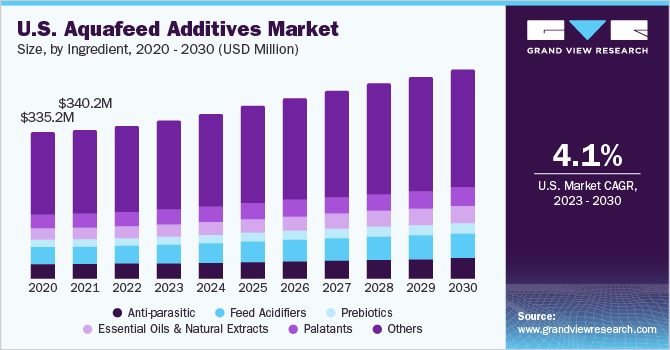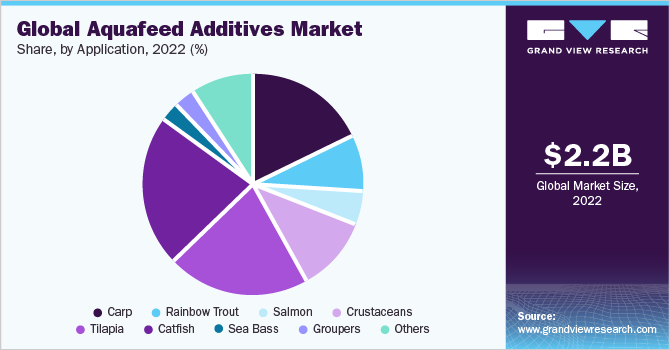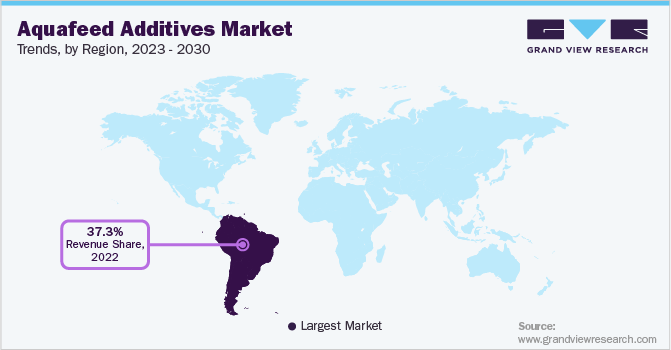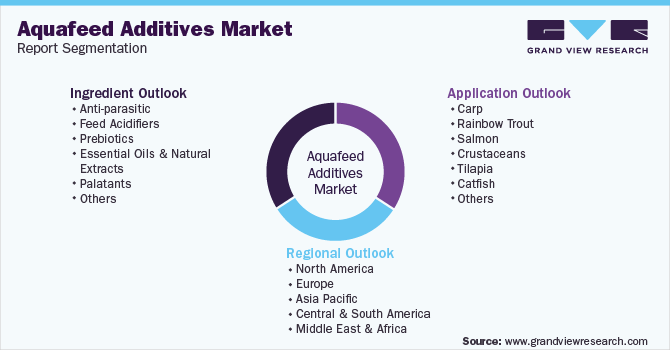- Home
- »
- Animal Feed and Feed Additives
- »
-
Aquafeed Additives Market Size, Share & Growth Report, 2030GVR Report cover
![Aquafeed Additives Market Size, Share & Trends Report]()
Aquafeed Additives Market Size, Share & Trends Analysis Report By Application (Tilapia, Catfish), By Ingredient (Feed Acidifiers, Anti-parasitic, Prebiotics), By Region, And Segment Forecasts, 2023 - 2030
- Report ID: GVR-3-68038-555-7
- Number of Report Pages: 150
- Format: PDF, Horizon Databook
- Historical Range: 2018 - 2021
- Forecast Period: 2023 - 2030
- Industry: Specialty & Chemicals
Report Overview
The global aquafeed additives market size was valued at USD 2.16 billion in 2022 and is anticipated to expand at a compound annual growth rate (CAGR) of 4.3% from 2023 to 2030. The market has been growing rapidly due to an increasing demand for fish and seafood products. This trend is expected to continue in the future as the global population continues to grow and the demand for protein from aquatic sources increases. The increasing global demand for fish and seafood products is a major growth driver for the market. As the global population continues to grow, the consumption of fish is anticipated to rise on account of several health benefits associated with it, including enhancing cognitive development in children, assisting in reducing the threat of cardiovascular diseases, and lowering the fat level in the body, which, in turn, reduces the threats associated with obesity. This, in turn, is projected to fuel the demand for healthy & disease-free fish and high-quality fish products, thus consequently boosting the consumption of aquafeed additives over the forecast period.

In North America, U.S. emerged as the major market for aquafeed additives, driven by the growing aquaculture industry and increasing consumption of fish and seafood products in the country. U.S. has a well-established aquaculture industry and a high per capita consumption of fish and seafood products, which is driving the growth of the market in the country.
The COVID-19 pandemic has had a significant impact on the market. The sudden outbreak of the pandemic in early 2020 led to a widespread disruption of global supply chains, resulting in delays and shortages of raw materials and finished products. This, in turn, has led to increased costs for aquafeed additive manufacturers, as well as reduced production capacity and limited availability of certain products.
In addition, the pandemic has also affected the demand for the product, as many fish farms and aquaculture operations have been forced to temporarily shut down or reduce their production levels due to quarantine measures and lockdowns. This has led to a decrease in demand for aquafeed additives, which has further compounded the challenges faced by manufacturers.
Ingredient Insights
The feed acidifiers segment dominated the market with the highest revenue share of more than 11% in 2022. As they are used to lower the pH level of animal feed, and they have become increasingly popular in recent years. The popularity is attributed to the increasing global population and rising demand for animal protein are driving the growth of the aquafeed industry, which in turn is driving the demand for feed acidifiers.
Feed acidifiers have been shown to have a number of benefits for fishes, such as improving feed efficiency, reducing the risk of disease, and improving gut health. These benefits are driving the use of feed acidifiers. Moreover, consumers are increasingly demanding natural and organic products, and this trend is also evident in the feed industry. As a result, manufacturers are increasingly using natural ingredients in feed acidifiers, such as organic acids like citric acid and lactic acid.
Antiparasitics ingredient will also grow significantly over the forecast period. As antiparasitics play an important role in the market. They are effective at preventing or controlling parasitic infections, which is essential for the health and growth of fish and other aquatic animals. They also have the added benefit of reducing the use of antibiotics, which is beneficial for the environment and for the health of the fish. The increasing demand for natural and organic products is also driving the use of natural ingredients in antiparasitics, which is expected to drive the market for antiparasitics in the future.
Application Insights
The catfish segment dominated the market with the highest revenue share of 22.1% in 2022. Catfish has become increasingly popular as a food source due to its taste and versatility, as well as its high nutritional value. This has led to an increase in demand for catfish in both developed and developing countries. Catfish are well-suited to aquaculture due to their hardiness and adaptability, and can be raised in both fresh and saltwater environments.
Catfish are omnivorous fish and have a diverse diet, which requires a complex feed formulation with a high nutritional value. This increases the demand for high-quality aquafeed additives such as vitamins, minerals, amino acids, and antioxidants to meet the nutritional requirements of catfish. Aquafeed additives such as antibiotics, antiparasitics, and probiotics play an important role in preventing and controlling these diseases, thus boosting the growth of the market.

Carp plays an important role in the growth of the market, driven by the high demand for the fish, the well-developed carp culture, the complex nutritional requirements of carp, the increasing adoption as an alternative to other species and their tolerance to environmental stressors. The continued popularity of carp and increasing adoption of carp culture in aquaculture is expected to drive the demand for high-quality aquafeed additives specifically formulated for carp culture in the future.
Regional Insights
The Central & South America region dominated the market with the highest revenue share of 37.3% in 2022. This is attributed to many factors such as this region is the largest and the fastest-growing region in the market. The region is home to some of the world's largest aquaculture industries, such as Brazil, Chile, and Ecuador which are driving the demand. The increasing population, and urbanization, which is driving the demand for fish as a source of protein, is also driving the market in the region.
North America region is estimated to expand at a CAGR of 4.0% by 2030. North America is another major market for aquafeed additives. The region has a well-developed aquaculture industry, particularly in U.S., which is driving the demand.In addition, the increasing awareness of the benefits of aquafeed additives, stringent regulations to ensure the safety and environmental impact of aquafeed ingredients, and government support for the aquaculture industry are expected to drive market growth in North America.

Europe is a relatively smaller market compared to Asia Pacific and North America, but it is expected to grow at a moderate rate in the future. The European Union has implemented strict regulations on the use of feed additives in aquaculture, which is expected to drive the demand for natural and organic feed additives.
Key Companies & Market Share Insights
The global aquafeed additives industry is highly competitive, with many players offering a wide range of products for different species of fish and other aquatic animals. Some of the key players in the market include Alltech, Biomar, Cargill, DuPont, and Nutreco. These companies have a strong global presence and offer a wide range of aquafeed additives, such as amino acids, vitamins, minerals, and enzymes.
To be competitive in the market, companies must offer high-quality products that are backed by research and meet industry standards. They must also be able to adapt to changing market conditions and customer needs, as well as regulatory requirements. Additionally, having a strong distribution network, good sales and marketing efforts, and having a competitive price point, are all important factors to remain competitive. For instance, DuPont has been recently investing in the market, such as the acquisition of a majority stake in Hwayoung, a leading South Korea-based producer of fish feed and animal nutrition. Some of the prominent key players in the global aquafeed additives market include:
-
Aker Biomarine
-
Nutriad Inc.
-
Calanus AS
-
Olmix Group
-
Norel SA
-
Lallemand Inc.
-
Alltech
-
Kemin Industries
-
Nouryon
-
DuPont de Nemours Inc
-
Biorigin
-
Phileo by Lesaffre
-
Calanus AS
Aquafeed Additives Market Report Scope
Report Attribute
Details
Market size value in 2023
USD 2.24 billion
Revenue forecast in 2030
USD 3.02 billion
Growth Rate
CAGR of 4.3% from 2023 to 2030
Base year for estimation
2022
Historical data
2018 - 2021
Forecast period
2023 - 2030
Quantitative units
Volume in Kilotons; Revenue in USD Million, and CAGR from 2023 to 2030
Report coverage
Revenue forecast, company ranking, competitive landscape, growth factors, and trends
Segments covered
Ingredient, application, region
Regional scope
North America; Europe; Asia Pacific; Central & South America; Middle East & Africa
Country scope
U.S.; Canada; Mexico; Germany; U.K.; France; Italy; Spain; Norway; China; India; Japan; South Korea; Vietnam; Thailand; Brazil; Argentina; Chile; Ecuador; South Africa; Iran; Egypt; Nigeria
Key companies profiled
Kemin Industries; Diana Group; Nouryon; Phileo by Lesaffre; DuPont de Nemours Inc.; Nutriad Inc.; Olmix Group; Lallemand Inc.; Biorigin; AKER BIOMARINE; Alltech
Customization scope
Free report customization (equivalent up to 8 analysts working days) with purchase. Addition or alteration to country, regional & segment scope.
Pricing and purchase options
Avail customized purchase options to meet your exact research needs. Explore purchase options
Global Aquafeed Additives Market Report Segmentation
This report forecasts revenue growth at global, regional, and country levels and provides an analysis of the latest industry trends in each of the sub-segments from 2018 to 2030. For the purpose of this study, Grand View Research has segmented the global aquafeed additives market report on the basis of ingredient, application, and region:

-
Ingredient Outlook (Volume, Kilotons; Revenue, USD Million, 2018 - 2030)
-
Anti-parasitic
-
Feed Acidifiers
-
Prebiotics
-
Essential Oils & Natural Extracts
-
Palatants
-
Hydrolysates
-
Yeast Extracts
-
-
Others
-
-
Application Outlook (Volume, Kilotons; Revenue, USD Million, 2018 - 2030)
-
Carp
-
Rainbow Trout
-
Salmon
-
Crustaceans
-
Tilapia
-
Catfish
-
Sea Bass
-
Groupers
-
Others
-
-
Regional Outlook (Volume, Kilotons; Revenue, USD Million, 2018 - 2030)
-
North America
-
U.S.
-
Canada
-
Mexico
-
-
Europe
-
Germany
-
U.K.
-
France
-
Italy
-
Spain
-
Norway
-
-
Asia Pacific
-
China
-
India
-
Japan
-
South Korea
-
Vietnam
-
Indonesia
-
Thailand
-
-
Central & South America
-
Brazil
-
Argentina
-
Chile
-
Ecuador
-
-
Middle East & Africa
-
South Africa
-
Iran
-
Egypt
-
Nigeria
-
-
Frequently Asked Questions About This Report
b. The global aquafeed additives market size was estimated at USD 2.19 billion in 2022 and is expected to reach USD 2.24 billion in 2023
b. The global aquafeed additives market is expected to grow at a compound annual growth rate of 4.3% from 2023 to 2030 to reach USD 3.02 billion by 2030.
b. Central & South America dominated the aquafeed additives market with a revenue share of over 37% in 2022. This is attributed to the favorable climatic conditions and availability of locally produced fish feed made from basic raw materials such as fish oil and fish meal.
b. Some key players operating in the aquafeed additives market include Nutriad; Olmix Group; Lallemand, Inc.; Kemin Industries, Inc; Biorigin; Nouryon; DuPont de Nemours, Inc; Delacon; Camlin Fine Sciences Ltd.; Phileo by Lesaffre; Diana Group; Alltech; Norel S.A.; Calanus AS; and Aker Biomarine
b. Key factors that are driving the aquafeed additives market growth include increasing demand for high protein content food and increasing direct human consumption of fish and fish products.
Share this report with your colleague or friend.
![gvr icn]()
NEED A CUSTOM REPORT?
We can customize every report - free of charge - including purchasing stand-alone sections or country-level reports, as well as offer affordable discounts for start-ups & universities. Contact us now
![Certified Icon]()
We are GDPR and CCPA compliant! Your transaction & personal information is safe and secure. For more details, please read our privacy policy.
We are committed towards customer satisfaction, and quality service.
"The quality of research they have done for us has been excellent."





